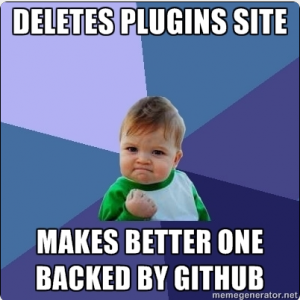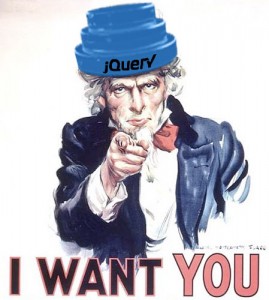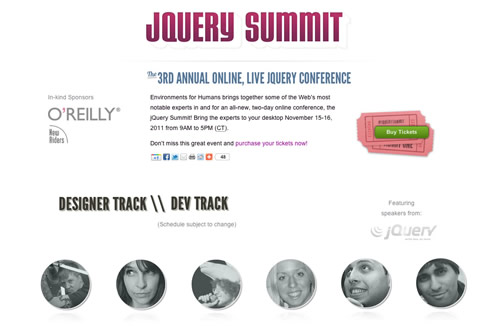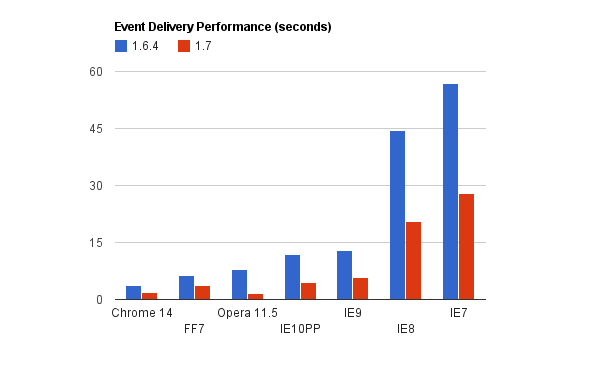jQuery 1.7 is ready for download! You can get the code from the jQuery CDN:
This new release should also be available on the Google and Microsoft CDNs within a day or two.
Thanks to your help in testing and reporting bugs during the beta period, we believe we have a solid, stable release. If you do find problems, file a bug and be sure to choose jQuery 1.7 in the version selection. Also be sure to provide a jsFiddle test case so we can quickly analyze the problem.
What’s New in jQuery 1.7
The Version 1.7 tag at the API site is a great way to get up to speed with the new things in this release. Here’s a rundown of the big items in 1.7 and some things not yet mentioned in the API docs.
New Event APIs: .on() and .off()
The new .on() and .off() APIs unify all the ways of attaching events to a document in jQuery — and they’re shorter to type!
$(elements).on( events [, selector] [, data] , handler );
$(elements).off( [ events ] [, selector] [, handler] );
When a selector is provided, .on() is similar to .delegate() in that it attaches a delegated event handler, filtered by the selector. When the selector is omitted or null the call is like .bind(). There is one ambiguous case: If the data argument is a string, you must provide either a selector string or null so that the data isn’t mistaken as a selector. Pass an object for data and you’ll never have to worry about special cases.
All the existing event binding methods (and their corresponding unbinding methods) are still there in 1.7, but we recommend that you use .on() for any new jQuery project where you know version 1.7 or higher is in use. Here are some examples of mapping between the old and new API calls:
$('a').bind('click', myHandler);
$('a').on('click', myHandler);
$('form').bind('submit', { val: 42 }, fn);
$('form').on('submit', { val: 42 }, fn);
$(window).unbind('scroll.myPlugin');
$(window).off('scroll.myPlugin');
$('.comment').delegate('a.add', 'click', addNew);
$('.comment').on('click', 'a.add', addNew);
$('.dialog').undelegate('a', 'click.myDlg');
$('.dialog').off('click.myDlg', 'a');
$('a').live('click', fn);
$(document).on('click', 'a', fn);
$('a').die('click');
$(document).off('click', 'a');
Improved Performance on Delegated Events
Event delegation has become increasingly important as size and complexity of pages grow. Application frameworks such as Backbone, JavaScriptMVC, and Sproutcore make heavy use of event delegation. With that in mind, jQuery 1.7 event handling was refactored with an eye to making delegated events much faster, especially for the most common cases.
To optimize the code for the most commonly used forms of selectors, we examined a cross-section of code from Google Codesearch. Nearly two-thirds of the selectors used in .live() and .delegate() method calls were in the form tag#id.class where one or more of tag, id, or class were used. By parsing those simple selectors in JavaScript at the time the event was attached, we were able to outperform even the browser’s native-code implementations of matchesSelector during event delivery. For more complex selectors we still use the Sizzle engine, so all existing code should continue to work.
The final result is that delegated events are delivered in about half the time they took in 1.6.4:
Better Support for HTML5 in IE6/7/8
Anyone who has tried to use the new HTML5 tags such as <section> has no doubt run across the problem that IE 6/7/8 not only don’t understand these tags, they actually remove them from the document. With jQuery 1.7 we built in support for using HTML5 tags in older IEs with methods like .html(). This support is on par with what previously required innerShiv. You must still include html5shiv (or Modernizr) in the head of your document in older IEs for HTML5 tag support. For more background, see The Story of the HTML5 Shiv.
Toggling Animations Work Intuitively
In previous versions of jQuery, toggling animations such as .slideToggle() or .fadeToggle() would not work properly when animations were stacked on each other and a previous animation was terminated with .stop(). This has been fixed in 1.7 so that the animation system remembers the elements’ initial values and resets them in the case where a toggled animation is terminated prematurely.
Asynchronous Module Definition (AMD)
jQuery now supports the AMD API. Note that jQuery 1.7 is not a script loader itself; it cooperates with AMD-compliant loaders such as RequireJS or curl.js so it can be loaded dynamically and the ready event can be controlled by the loader. Now an AMD-compliant loader can load an unmodified version of jQuery 1.7 from a CDN such as Google’s or Microsoft’s. Many thanks to James Burke (@jrburke) for submitting the patch and unit tests, then waiting patiently for us to incorporate it.
jQuery.Deferred
The jQuery.Deferred object has been extended with new progress handlers and notification methods that call those handlers. This allows you to asynchronously notify listeners of progress in a request without resolving or rejecting the request. In addition, there is a new state() method that returns the current state of the Deferred; it’s primarily useful for debugging.
Deferreds are now implemented using a new jQuery.Callbacks feature, a generalized way of queueing and triggering a series of handlers. This feature may be of interest to plugin writers, although Deferreds and the event subsystem provide a higher-level interface for this type of functionality.
jQuery.isNumeric()
Inside jQuery we’ve found several situations where we need to know if an argument is numeric, or would be successfully converted to a number if it is some other type. We decided to write and document jQuery.isNumeric() since it’s a useful utility. Pass it an argument of any type and it returns true or false as appropriate.
Removed Features
event.layerX and event.layerY: We have removed these non-standard properties in version 1.7. Although we normally would have gone through a deprecation notice period for these, Chrome version 16 generates a flood of console warning messages on the page. Because of this, we decided to remove them immediately. On platforms that still support these properties, they are available through event.originalEvent.layerX and event.originalEvent.layerY.
jQuery.isNaN(): This undocumented utility function has been removed. It was confusing because it appropriated the name of a built-in JavaScript function but did not have the same semantics. The new jQuery.isNumeric() serves a similar purpose, but has the benefit of being documented and supported. Despite jQuery.isNaN() being undocumented, several projects on Github were using it. We have contacted them and asked that they use jQuery.isNumeric() or some other solution.
jQuery.event.proxy(): This undocumented and deprecated method has been removed. Users should be calling the documented jQuery.proxy method instead.
The jQuery Team, and Your Part
I want to recognize the incredible work of our regular team contributors in getting this release out the door, especially Timmy Willison (timmywil on Github), Corey Frang (gnarf), Rick Waldron (rwldrn), and Julian Aubourg (jaubourg). Karl Swedberg (kswedberg) and Addy Osmani (addyosmani) worked hard on getting the new documentation into shape on the API site. Also, thanks to Mike Sherov (mikesherov), a greenhorn contributor who has already created patches for several tricky bugs. Many thanks to all the others who reported bugs, submitted pull requests, reviewed commits, and in other ways made sure we did the best job we possibly could.
Still, we can always use more help, and that is where you can contribute. The simplest and most important thing you can do is occasionally test our work-in-progress against your code and your expectations. It’s always located at http://code.jquery.com/jquery-git.js and a fresh copy is built each time a new commit is made to our master branch at github.com. If you find a bug in a final release, test against jquery-git.js to see if it’s already been fixed. It’s easy as pie since jsFiddle.net offers an option to test your code with the jquery-git.js file as “jQuery (edge)”.
If you’d like to do more, we’d be glad to have you pitch in! We’ve written a document that can get you started with the process, and one or more of us are generally available in the #jquery-dev channel on IRC if you need more help or information.
jQuery 1.7 Change Log
The current change log of the 1.7 release.
Ajax
- #9399: Deprecate jqXHR.success and jqXHR.error
Attributes
- #5479: removeAttr: remove multiple attributes
- #6743: map enctype to encoding, depending on browser
- #10176: Injected script tag is evaluated twice
- #10278: checkboxEl.attr(‘checked’) returns stale value after checkboxEl.click()
- #10429: IE7 – invalid procedure call or argument when calling removeAttr(‘contenteditable’);
- #10514: removeAttr does not remove the class attribute in IE6/7
Core
- #6485: Solution for HTML5 in IE
- #7102: Register jQuery as a CommonjS async module
- #9453: $.inArray does not support fromIndex
- #10478: Switch jQuery.isNaN to jQuery.isNumeric
Css
- #10267: IE8 and window is(‘:visible’) crashes
Data
- #7323: Allow removing multiple data keys at once with $.fn.removeData
- #8909: $(element).data() will scan all attributes more than needed.
- #8921: jQuery private data should stay private
Deferred
- #8856: Request: deferred.isUnresolved()
- #9033: try{ } finally{ } error in IE8
- #9398: Proposal for Improved Deferreds
Dimensions
- #9434: .outerWidth()/.outerHeight()/.innerWidth()/.innerHeight() should work on window and document
Effects
- #5684: Effects: exception in animation callback causes endless loop
- #6150: .stop sometimes doesn’t clear .delay
- #6641: Calling stop() within animation finished callback causes other animations to freeze
- #8685: Animations should keep track of animation state in order to properly address stacked animations
- #9280: Allow multiple effect queues for animate()
- #9548: animate does not work with fill-opacity css property for svg elements
- #10445: Setting queue to true causes an error
- #10497: .stop should allow choosing which queue to stop
- #10622: .show() does not properly restore CSS-set “display” value
Event
- #3368: event.metaKey should be assigned to event.ctrlKey on Non-Mac only
- #6170: jQuery(window).scroll(); causes IE* to scroll to 0,0
- #6319: Regression: stopPropagation inside change handlers in IE is incorrectly applied to keydown event
- #6386: support data argument for live events via “event.special.live.add”
- #6593: IE8: DOM 0 event handler called twice when a separate handler is attached via jQuery
- #6667: submit event doesn’t delegate in IE* under certain conditions
- #6903: special events need a way to determine whether they are being bound with .bind vs .live/.delegate
- #6942: JQuery.event.fix causes unnecessary reflows in IE when handling key events
- #7139: “hover” event alias should work for .bind as well as .live
- #7161: Submit event on a form element not unbound properly in IE
- #7444: Submitting form with “Enter” instead of button click on ie8 or ie7 triggers live submit event twice.
- #8157: Focusing an already focused text field will prevent the change event from firing in IE
- #8728: Event ‘mouseenter’ not firing when the element being left is removed on leaving
- #8789: Meta: Event Property Hooks
- #8858: Special events – _default method doesn’t have access to the `data` argument of the trigger method
- #8866: IE8 input[type=file] delegated change event files only on blur
- #8982: bind(“unload someOther”) => on unload, handler is not executed only once.
- #9069: when hover over a child of an element, mouseleave fires when using live or delegate
- #9279: delegate() bind does not handle mouseover/mouseout and mouseenter/mouseout correctly for selected elements
- #9393: Unify and DRY out event system
- #9593: Delegated submit event is not instanceof jQuery.Event in IE
- #9724: Infinite loop in trigger function when window.parentNode is a DOM element
- #9901: event.handleObj.namespace incorrect when using .delegate
- #9933: jQuery.fn.toggle() should store state in private data object
- #9951: Wrong order in .trigger() when DOM is modified in a handler
- #10375: Do not include `type` in jQuery.event.props
- #10438: Rename jQuery.event.propHooks => .fixHooks
- #10468: Remove deprecated jQuery.event.guid and jQuery.event.proxy
- #10489: Disconnected elements bubble to window on .trigger()
- #10531: Consider removing layerX and layerY from $.event.props
- #10563: jQuery.Event no longer contains the element that matched the selector in event delegation.
- #10567: Delegated events incorrectly match class names
- #10575: Breaking changes in live event propagation between 1.6.4 and 1.7rc1
- #10576: jQuery1.7rc1 and jQueryMobile1.0rc2 – IE gets error in jqm triggerCustomEvent method
Manipulation
- #6782: carefully allow more strings to use innerHTML
- #7037: Duplicate mouseover and mouseout events added to cloned element.
- #10501: HTML5 element “innerShiv” inconsistent across html()/append()
Misc
- #10420: MouseWheel
- #10553: Further reduction of minimal license header
Selector
- #3144: Inconsistent cross-browser results from .text() method
- #5637: Boolean (and Empty) Attribute Selectors Fail
- #6863: faster getText
- #7128: attribute selector is inconsistent between qSA and Sizzle due to use of DOM properties
- #8539: Sizzle cache collision in browsers without querySelectorAll
- #9261: Has Attribute not working in filter/children/siblings
- #9570: Selector $(‘form[name=”..”]’) returns zero elements in IE8 under some conditions
- #10178: $(window).is(“a”) >> Uncaught TypeError: Cannot call method ‘toLowerCase’ of undefined
- #10315: Sizzle ignores seed argument when using positional selectors
- #10562: siblings method returns unexpected elements when using Sizzle-invoking pseudo-selectors
Support
- #5145: jQuery.support.opacity = false in the Chrome browser
- #6809:








